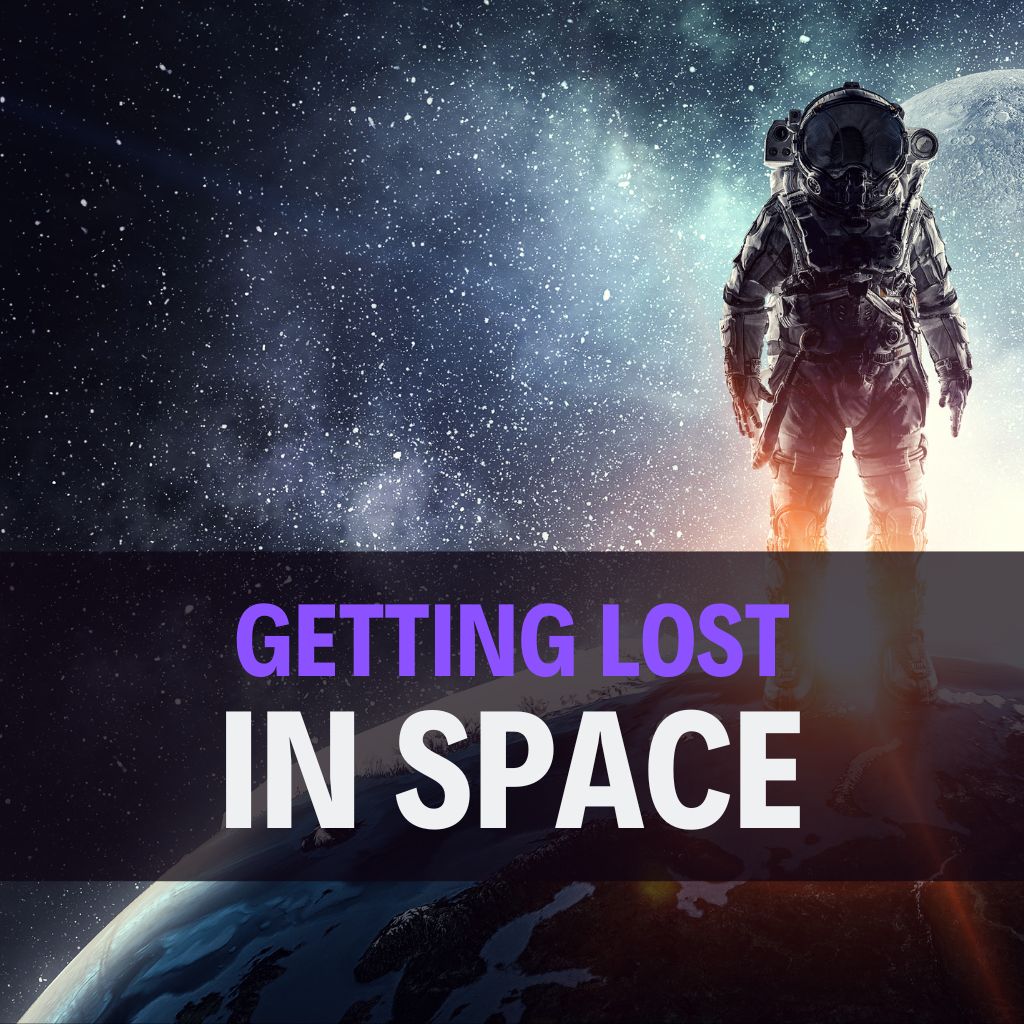This site contains affiliate links to products. I may receive a commission for purchases made through these links.
Getting lost in space is a concept that evokes a sense of profound isolation, uncertainty, and danger. It raises questions about the challenges astronauts and spacecraft face as they navigate the vastness of the universe.
While extensive training, advanced technology, and meticulous planning help mitigate the risks, the ever-present possibility of disorientation or encountering unforeseen obstacles remains. The recurring question becomes: What will happen to a person lost in space?
In this article, we will explore intriguing questions about getting lost in space.
1. Can you get lost in space?
If a person were to lose their way into space beyond Earth’s orbit, it would be difficult to determine their eventual destination. Depending on their speed and trajectory, they could potentially venture beyond the boundaries of the solar system.
Also, they may be affected by the gravitational pull of another celestial body along their path.
However, since such a scenario has never occurred, scientists do not know precisely about the outcome. In the vastness of outer space, the functionality of a space suit is vital to protect the human body and prevent a person from getting lost.
2. What does it mean to “get lost in space,” and how is it different from simply being adrift in space?
Getting lost in space refers to an astronaut or spacecraft losing track of their precise location or orientation relative to their intended trajectory or destination. It implies a loss of situational awareness and the inability to determine the correct path to follow.
On the other hand, being adrift in space typically refers to being in a state of motion without any specific destination or purpose.
3. Has anyone been lost in space? Are there astronauts lost in space forever?
No astronaut has been lost in space in the sense of being permanently adrift or unable to return to Earth. All manned space missions have had detailed plans and systems in place to ensure the astronauts’ safe return.
However, there have been tragic incidents, such as the Apollo 1 fire in 1967 and the Space Shuttle Challenger and Columbia accidents, where astronauts lost their lives during space missions.
4. Are there any dead bodies in space?
There are no intact human bodies in space. Incidents related to spaceflight involving individuals typically occur while they are still on Earth rather than in the space environment.
In the case of the Space Shuttle Challenger and Columbia accidents, the astronauts’ remains were recovered after the spacecraft disintegrated during re-entry.
5. How many astronauts have died in space?
No astronauts have died while in space. However, there have been tragic incidents during space missions that resulted in the loss of astronauts’ lives.
In each case, the fatalities occurred during launch or re-entry, not while astronauts were in the vacuum of space itself.
Vladimir Komarov, the first astronaut to perish during a space flight, met his tragic fate on April 24, 1967, when his Soyuz capsule experienced a parachute malfunction upon re-entry. Consequently, the capsule crashed into the ground, marking a solemn milestone in the history of space exploration.
6. Are there any hypothetical scenarios where an astronaut could be irretrievably lost in space without any possibility of rescue?
While space missions prioritize the safety and well-being of astronauts, hypothetical scenarios could be envisioned where an astronaut might be irretrievably lost in space.
For example, if an astronaut were to become detached from their spacecraft during a spacewalk and propulsion systems failed, their ability to return to safety would be severely compromised.
7. What do astronauts do if they get lost in space?
If an astronaut were to find themselves in such a situation, their chances of survival would be extremely slim, and the most probable outcome would be death caused by asphyxiation.
However, before it gets to that, they have a crucial tool at their disposal known as the SAFER (Simplified Aid for EVA Rescue) jet pack.
The SAFER jet pack is a backpack-like device designed specifically for emergencies during extravehicular activities (EVAs) or spacewalks. It is equipped with small thrusters that provide propulsion, allowing the astronaut to maneuver and navigate their way back to the safety of the space station or spacecraft.
8. How do astronauts keep track of their location while navigating the Earth’s orbit, and how do they maintain their orientation in the vastness of space?
Astronauts and space agencies employ various methods to keep track of their location and orientation in space. They use navigational systems to determine their position relative to their intended trajectory.
Mission control centers on Earth provide continuous monitoring and guidance, exchanging data and instructions with astronauts. Visual references, such as landmarks on Earth or other celestial objects, can be used to aid in navigation.
If you aspire to venture into space one day, you can enhance your familiarity with deep-space objects by acquiring a telescope. This invaluable tool allows you to observe and study celestial phenomena. Here are two telescope recommendations, each serving a specific purpose:
The Celestron PowerSeeker 127EQ Telescope is an excellent choice for those seeking affordability. With its 127mm aperture and sturdy equatorial mount, it offers clear and detailed views of deep space objects, including galaxies, nebulae, and star clusters.
The Orion StarBlast 4.5 Astro Reflector Telescope is specifically designed for beginners. Its compact and portable design makes it easy to set up and use. The telescope provides a wide field of view, allowing beginners to explore the moon, planets, and brighter deep space objects with clarity and ease.
You may also like: 9 Best Deep Space Telescopes (Ranked!)
9. What psychological effects can occur when astronauts feel lost or disoriented in space, and how are these challenges addressed?
Feeling lost or disoriented in space can lead to psychological effects such as anxiety, stress, or a loss of confidence. Astronauts are trained to manage these challenges through psychological support and coping strategies.
They have access to a range of resources and support systems to address these psychological effects.
Space agencies prioritize the mental well-being of astronauts by providing pre-mission psychological evaluations, ongoing counseling, and communication channels with mental health professionals.
Debriefing sessions following missions allow astronauts to reflect on their experiences, discuss any difficulties encountered, and provide valuable feedback for future mission planning.
10. How does the concept of “lost in space” apply to robotic spacecraft or probes, and what measures are taken to prevent them from getting lost?
The concept of “lost in space” can also apply to robotic spacecraft or probes. These unmanned missions rely on precise navigation to reach their intended destinations and carry out their scientific objectives.
To prevent them from getting lost, meticulous planning, trajectory calculations, and continuous monitoring are employed.
Navigation systems such as star trackers, inertial measurement units, and radio-based communication with Earth help maintain the spacecraft’s position and orientation.
11. What are some real-life examples where spacecraft or probes have encountered navigation challenges or gotten temporarily off course?
One notable instance is the Mars Climate Orbiter mission in 1999, where an error in units during communication between different teams led to an incorrect trajectory calculation. As a result, the spacecraft entered Mars’ atmosphere at an incorrect angle and was lost.
12. What lessons have been learned from past space missions or incidents that have helped improve navigation and prevent astronauts from getting lost?
Past space missions and incidents have underscored the importance of clear communication, robust quality control procedures, and meticulous verification of calculations and units.
They have also highlighted the need for redundancy in critical systems, rigorous testing, and enhanced training for mission teams. It has also led to the development of advanced navigation technologies, such as more accurate sensors, improved software algorithms, and real-time monitoring capabilities.
The zero-pressure environment of space poses an incredibly attractive challenge for exploration, but it requires a sophisticated cooling system to prevent the human body from freezing solid.
Astronauts rely on their space suits to regulate oxygen supply, preventing oxygen deprivation and maintaining their well-being in harsh space conditions.
13. How does the absence of gravity affect an astronaut’s perception of direction and orientation in space?
On Earth, our perception of direction is influenced by gravity’s constant pull and the resulting vertical orientation. In space, without this reference, astronauts may experience a disorienting sensation known as the “space adaptation syndrome.”
This can lead to difficulties in determining up and down, as well as a reduced sense of spatial awareness.
14. How do astronauts ensure they don’t get lost within the vast and complex interior of a space station?
To navigate within a space station’s vast and complex interior, astronauts rely on various aids and training. The space station is equipped with a network of handrails, labels, color-coded indicators, and lighting systems to provide visual cues and aid in orientation.
Astronauts also undergo extensive training, including virtual reality simulations and familiarization with the layout of the space station. They use communication systems to stay in contact with their crewmates and ground control, ensuring they can navigate collaboratively and receive guidance if needed.
These measures help astronauts maintain spatial awareness and prevent getting lost within the intricate environment of a space station.
The Skylab orbital workshop, which serves as the primary section of America’s first space station, is the largest module comprising living quarters, workspaces, storage areas, research equipment, and essential supplies to sustain a series of three-man crews.
15. What measures are being taken to prevent astronauts and spacecraft from getting lost or endangered due to space debris?
Various measures have been implemented to prevent astronauts and spacecraft from getting lost or endangered due to space debris. This includes tracking and monitoring systems to identify potential collision risks.
There are also collision avoidance maneuvers, adherence to debris mitigation guidelines, the use of shielding and hardened materials, and international cooperation for space traffic management.
16. How does re-entry into Earth’s atmosphere pose a risk of getting lost, and what precautions are taken to ensure a safe return for astronauts?
Re-entry into Earth’s atmosphere poses risks that can lead to getting lost or endangering the lives of astronauts. As a spacecraft descends through the atmosphere, it encounters extreme heat and forces that can impact its trajectory and stability.
Precise calculations and control mechanisms are employed to ensure the spacecraft enters the atmosphere at the correct angle and maintains a stable descent.
Navigation systems, such as inertial measurement units and GPS, are utilized to monitor the spacecraft’s position and velocity during re-entry.
Takeaway: Uncover the concept of getting lost in the vastness of space
The concept of getting lost in space raises intriguing questions about the challenges and risks faced by astronauts and spacecraft during space exploration. It will leave you wondering about what will happen to people lost in space. If you lose contact with Earth, it can be a disorienting experience, highlighting the importance of communication systems.
While astronauts are trained to manage the psychological effects of feeling lost or disoriented in space, their potential dangers and challenges are significant.
Astronauts wear space suits during their missions to navigate the dangers of outer space and maintain contact with mission control. Technological advancements, such as improved sensors, autonomous navigation systems, and optical and quantum navigation techniques, are continuously being developed to enhance spacecraft’s navigation and orientation capabilities.
Lessons learned from past incidents have also contributed to improved navigation protocols and procedures. As we continue to push the boundaries of space exploration, these advancements and lessons learned will play a crucial role in ensuring the success and safety of future missions, expanding our knowledge of the universe, and furthering our understanding of our place within it.
You may also like:







